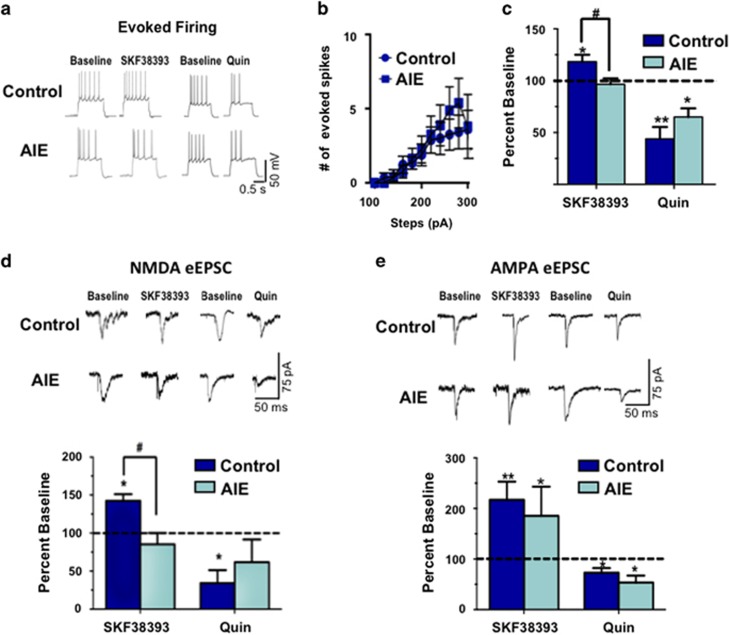Figure 5.
Adolescent intermittent ethanol exposure results in a loss of D1 receptor modulation of firing frequency and synaptic activity of pyramidal neurons in layer V of the prelimbic cortex (PrL-C). (a) Representative traces of the effect of the D1 receptor agonist SKF38393 (5 μM) and the D2 receptor agonist quinpirole (5 μM) on evoked firing frequency of layer V pyramidal neurons in PrL-C slices obtained from adult adolescent intermittent ethanol (AIE)-exposed and age-matched control rats. Top traces show firing in slices from control rats and bottom traces show firing in slices from AIE exposed rats. (b) Evoked firing frequency was not significantly different in slices from control rats compared with AIE-exposed rats. (c) In slices from control rats, SKF38393 increased evoked firing compared with baseline firing but had no effect in slices from AIE exposed rats. Bath application of quinpirole resulted in significant reduction of evoked firing in both control and AIE-exposed rats (n=6–10 cells per group; *p<0.05 and **p<0.01 for drug vs its respective baseline). (d) In slices obtained from control rats, D1 receptor stimulation significantly increased the amplitude of eNMDA currents (n=6–7 cells per group, #p<0.01, control vs AIE; *p<0.05, drug vs its respective baseline). This effect was not observed in slices obtained from AIE-exposed rats. D2 receptor stimulation resulted in a significant decrease in amplitude of eNMDA currents in control rats, and while slices from AIE-exposed rats showed an overall reduction in eNMDA currents in response to quinpirole, this did not reach statistical significance (n=5–6 cells per group, *p<0.01). (e) AIE exposure did not have an effect on D1 or D2 receptor modulation of AMPA currents. D1 stimulation significantly increased the amplitude of eAMPA currents in both groups (n=6–9 cells per group, *p<0.05) and D2 receptor stimulation significantly decreased the amplitude of evoked AMPA currents (n=3–8 cells per group, **p<0.01). All values represent the mean±SEM. eNMDA, evoked NMDA.

